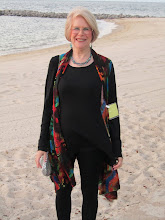
Too bad about the weather.... I would have loved better photos... but I did the best I could.
The Qutb complex is a collection of monuments and buildings but most noted for its 5 storied, 239 ft minar built in 1192. This is done in the early Afghan style which evolved into Indo-Islamic architecture. The complex also initially housed 27 Jain temples which were destroyed and whose materials were used to build the Quwwat-ul-Islam Mosque which stands beside the Qutb Minar. Because of the restrictions on the use of human forms in Islam, the large stones from the Jain temples were defaced but you can still see the influences. It was the first mosque built in Delhi after the Islamic conquest of India and the oldest surviving example of Ghurids (12th-13th century) architecture in India.
Iron Pillar :"The iron pillar is one of the world’s foremost metallurgical curiosities. The pillar, 7.21 metre high and weighing more than six tonnes, was originally erected by Chandragupta II Vikramaditya (375–414 AD) in front of a Vishnu Temple complex at Udayagiri around 402 AD, and later shifted by Aanagpal in 10th Century AD from Udaygiri to its present location. Anangpal built a Vishnu Temple here and wanted this pillar to be a part of that temple.
The estimated weight of the decorative bell of the pillar is 646 kg while the main body weighs 5865 kg thereby making the entire pillar weigh at 6,511 kg. The pillar bears an inscription in Sanskrit in Brahmi script dating 4th century AD, which indicates that the pillar was set up as a Vishnudhvaja, standard of god Vishnu, on the hill known as Vishnupada in memory of a mighty king named Chandra, believed to Chandragupta II. A deep socket on the top of this ornate capital suggests that probably an image of Garuda was fixed into it, as common in such flagpoles." From Wikipedia as their explanation is better than mine.
The Mughal emperor Humayun's tomb was commissioned 9 years after his death by one of his wives. It was started in 1565 and finished in 1572. It was the first garden tomb in India and the first structure to use red sandstone on such a large scale. It was designed by a Persian architect, Mirak Mirza Ghiyath, and featured Persian style gardens. This is the first of many structures in this style and it has been called the mini Taj.... it isn't very small.
 |
| India Gate |
 |
| Presidential Palace |

Next day I was on my own. Ned had a business meeting. I was planning on picking up some other goodies, but other than another outfit, I did not find anything special. I spent several hours walking around the area. It was quite safe. There was an Indian wedding being held on the hotel grounds so I spent a lovely time ogling the ladies in their very heavily embroidered saris and heavy jewelry. Too bad I couldn't take any pictures. It was a stunning sight.










No comments:
Post a Comment